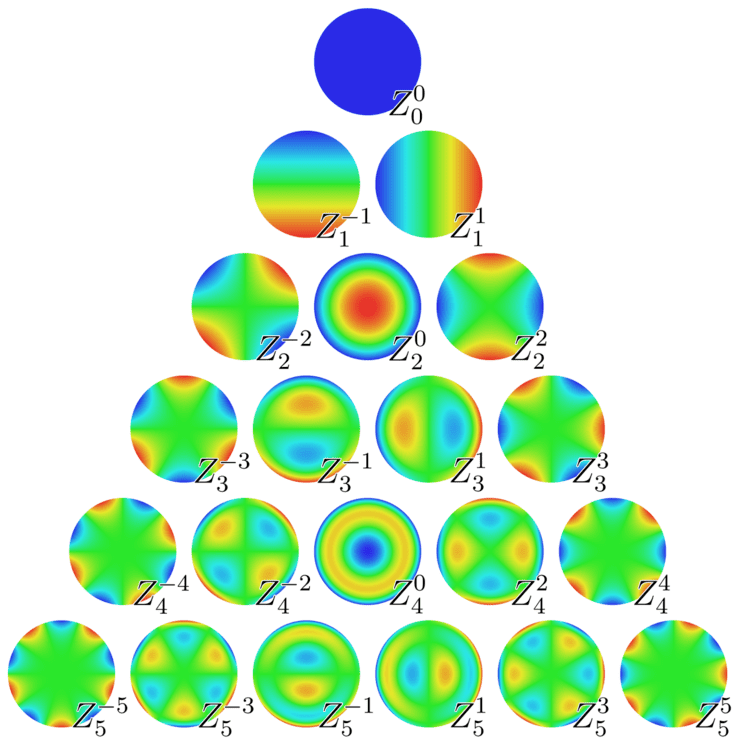 | ||
In mathematics, the Zernike polynomials are a sequence of polynomials that are orthogonal on the unit disk. Named after optical physicist Frits Zernike, winner of the 1953 Nobel Prize in Physics and the inventor of phase-contrast microscopy, they play an important role in beam optics.
Contents
Definitions
There are even and odd Zernike polynomials. The even ones are defined as
and the odd ones as
where m and n are nonnegative integers with n ≥ m, φ is the azimuthal angle, ρ is the radial distance
for n − m even, and are identically 0 for n − m odd.
Other representations
Rewriting the ratios of factorials in the radial part as products of binomials shows that the coefficients are integer numbers:
A notation as terminating Gaussian hypergeometric functions is useful to reveal recurrences, to demonstrate that they are special cases of Jacobi polynomials, to write down the differential equations, etc.:
for n − m even.
Noll's sequential indices
Applications often involve linear algebra, where integrals over products of Zernike polynomials and some other factor build the matrix elements. To enumerate the rows and columns of these matrices by a single index, a conventional mapping of the two indices n and m to a single index j has been introduced by Noll. The table of this association
The rule is that the even Z (with even azimuthal part m,
Orthogonality
The orthogonality in the radial part reads
Orthogonality in the angular part is represented by
where
where
A special value is
Zernike transform
Any sufficiently smooth real-valued phase field over the unit disk
where the coefficients can be calculated using inner products. On the space of
The Zernike coefficients can then be expressed as follows:
Alternatively, one can use the known values of phase function G on the circular grid to form a system of equations. The phase function is retrieved by the unknown-coefficient weighted product with (known values) of Zernike polynomial across the unit grid. Hence, coefficients can also be found by solving a linear system, for instance by matrix inversion. Fast algorithms to calculate the forward and inverse Zernike transform use symmetry properties of trigonometric functions, separability of radial and azimuthal parts of Zernike polynomials, and their rotational symmetries.
Symmetries
The parity with respect to reflection along the x axis is
The parity with respect to point reflection at the center of coordinates is
where
The periodicity of the trigonometric functions implies invariance if rotated by multiples of
Recurrence relations
The Zernike polynomials satisfy the following recurrence relation which depends neither on the degree nor on the azimuthal order of the radial polynomials:
From the definition of
The above relation is especially useful since the derivative of
Radial polynomials
The first few radial polynomials are:
Zernike polynomials
The first few Zernike modes, ordered by Noll index
Applications
The functions are a basis defined over the circular support area, typically the pupil planes in classical optical imaging at visible and infrared wavelengths through systems of lenses and mirrors of finite diameter. Their advantages are the simple analytical properties inherited from the simplicity of the radial functions and the factorization in radial and azimuthal functions; this leads, for example, to closed-form expressions of the two-dimensional Fourier transform in terms of Bessel functions. Their disadvantage, in particular if high n are involved, is the unequal distribution of nodal lines over the unit disk, which introduces ringing effects near the perimeter
In precision optical manufacturing, Zernike polynomials are used to characterize higher-order errors observed in interferometric analyses, in order to achieve desired system performance.
In optometry and ophthalmology, Zernike polynomials are used to describe aberrations of the cornea or lens from an ideal spherical shape, which result in refraction errors.
They are commonly used in adaptive optics, where they can be used to effectively cancel out atmospheric distortion. Obvious applications for this are IR or visual astronomy and satellite imagery. For example, one of the Zernike terms (for m = 0, n = 2) is called "de-focus". By coupling the output from this term to a control system, an automatic focus can be implemented.
Another application of the Zernike polynomials is found in the Extended Nijboer–Zernike (ENZ) theory of diffraction and aberrations.
Zernike polynomials are widely used as basis functions of image moments. Since Zernike polynomials are orthogonal to each other, Zernike moments can represent properties of an image with no redundancy or overlap of information between the moments. Although Zernike moments are significantly dependent on the scaling and the translation of the object in a region of interest (ROI), their magnitudes are independent of the rotation angle of the object. Thus, they can be utilized to extract features from images that describe the shape characteristics of an object. For instance, Zernike moments are utilized as shape descriptors to classify benign and malignant breast masses. Zernike Moments also have been used to quantify shape of osteosarcoma cancer cell lines in single cell level. These quantifiers of cell shape have been used to distinguish between high invasive cancer cell lines from low invasive lines.
Higher dimensions
The concept translates to higher dimensions D if multinomials
(Note that a factor
for even
